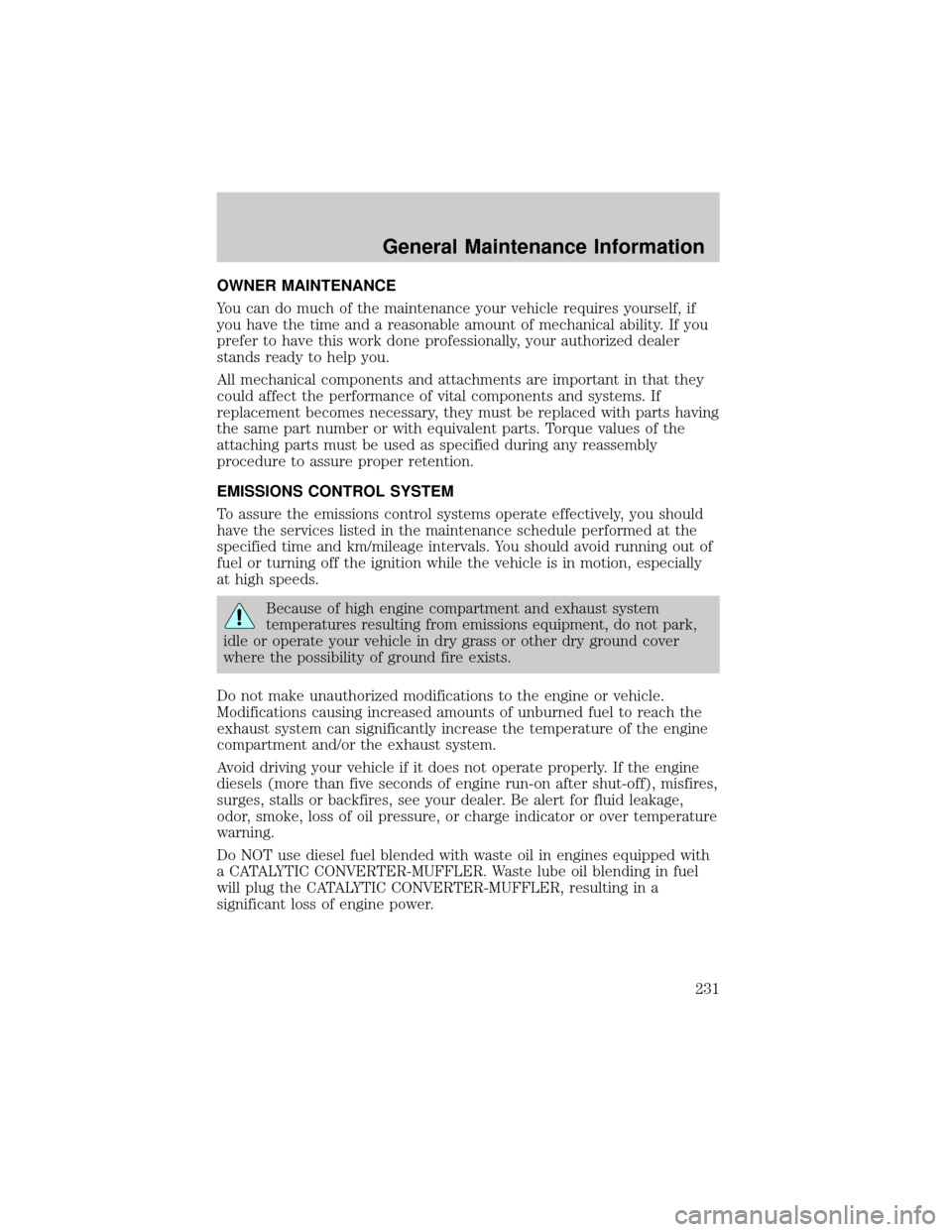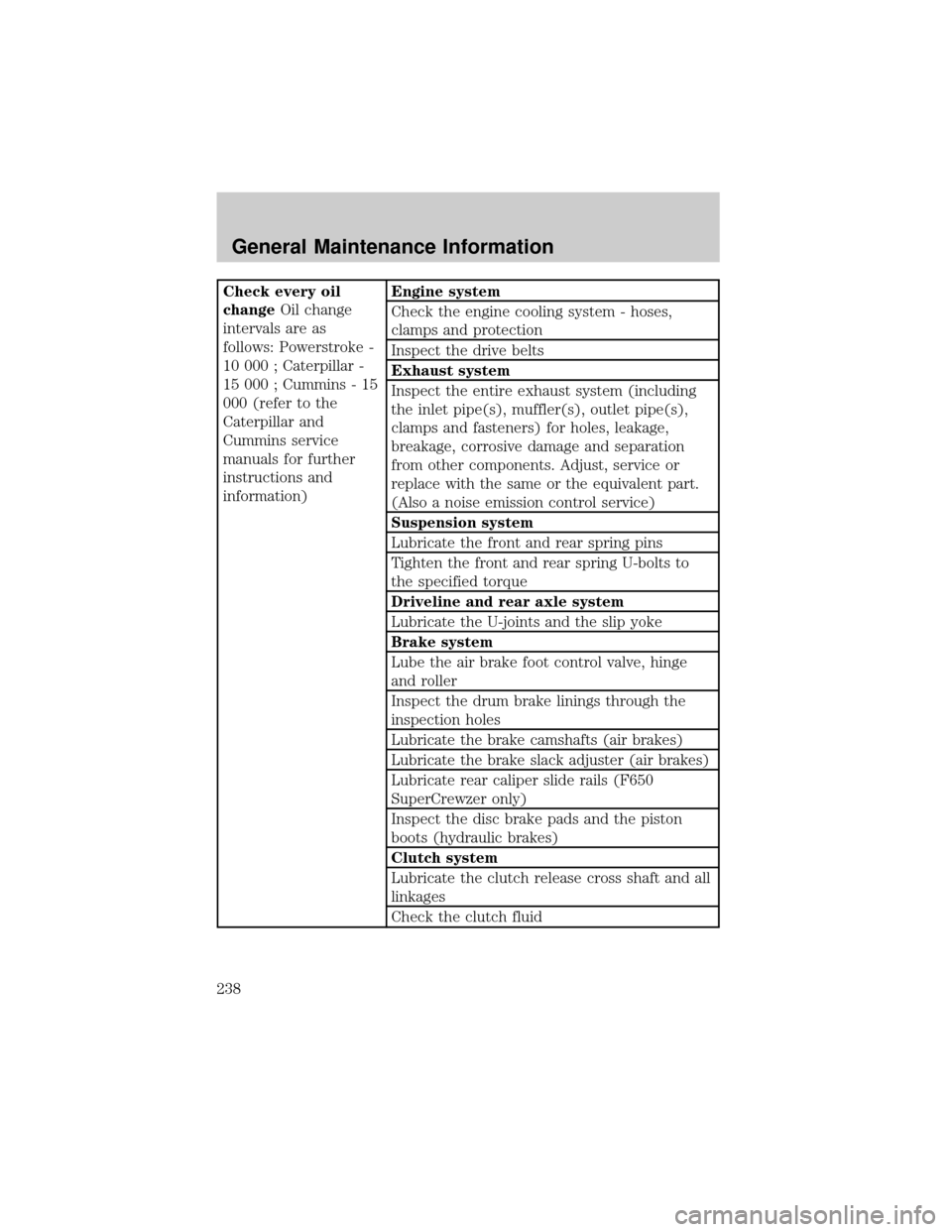Torque FORD F650 2002 10.G User Guide
[x] Cancel search | Manufacturer: FORD, Model Year: 2002, Model line: F650, Model: FORD F650 2002 10.GPages: 256, PDF Size: 1.75 MB
Page 231 of 256

OWNER MAINTENANCE
You can do much of the maintenance your vehicle requires yourself, if
you have the time and a reasonable amount of mechanical ability. If you
prefer to have this work done professionally, your authorized dealer
stands ready to help you.
All mechanical components and attachments are important in that they
could affect the performance of vital components and systems. If
replacement becomes necessary, they must be replaced with parts having
the same part number or with equivalent parts. Torque values of the
attaching parts must be used as specified during any reassembly
procedure to assure proper retention.
EMISSIONS CONTROL SYSTEM
To assure the emissions control systems operate effectively, you should
have the services listed in the maintenance schedule performed at the
specified time and km/mileage intervals. You should avoid running out of
fuel or turning off the ignition while the vehicle is in motion, especially
at high speeds.
Because of high engine compartment and exhaust system
temperatures resulting from emissions equipment, do not park,
idle or operate your vehicle in dry grass or other dry ground cover
where the possibility of ground fire exists.
Do not make unauthorized modifications to the engine or vehicle.
Modifications causing increased amounts of unburned fuel to reach the
exhaust system can significantly increase the temperature of the engine
compartment and/or the exhaust system.
Avoid driving your vehicle if it does not operate properly. If the engine
diesels (more than five seconds of engine run-on after shut-off), misfires,
surges, stalls or backfires, see your dealer. Be alert for fluid leakage,
odor, smoke, loss of oil pressure, or charge indicator or over temperature
warning.
Do NOT use diesel fuel blended with waste oil in engines equipped with
a CATALYTIC CONVERTER-MUFFLER. Waste lube oil blending in fuel
will plug the CATALYTIC CONVERTER-MUFFLER, resulting in a
significant loss of engine power.
General Maintenance Information
231
Page 238 of 256

Check every oil
changeOil change
intervals are as
follows: Powerstroke -
10 000 ; Caterpillar -
15 000 ; Cummins - 15
000 (refer to the
Caterpillar and
Cummins service
manuals for further
instructions and
information)Engine system
Check the engine cooling system - hoses,
clamps and protection
Inspect the drive belts
Exhaust system
Inspect the entire exhaust system (including
the inlet pipe(s), muffler(s), outlet pipe(s),
clamps and fasteners) for holes, leakage,
breakage, corrosive damage and separation
from other components. Adjust, service or
replace with the same or the equivalent part.
(Also a noise emission control service)
Suspension system
Lubricate the front and rear spring pins
Tighten the front and rear spring U-bolts to
the specified torque
Driveline and rear axle system
Lubricate the U-joints and the slip yoke
Brake system
Lube the air brake foot control valve, hinge
and roller
Inspect the drum brake linings through the
inspection holes
Lubricate the brake camshafts (air brakes)
Lubricate the brake slack adjuster (air brakes)
Lubricate rear caliper slide rails (F650
SuperCrewzer only)
Inspect the disc brake pads and the piston
boots (hydraulic brakes)
Clutch system
Lubricate the clutch release cross shaft and all
linkages
Check the clutch fluid
General Maintenance Information
238
Page 244 of 256

Maintenance Operation Frequency - Observation
Check the transmission and
engine mountings (*b)Hard shifting or excessive vibration
Check and adjust transmission
controls (*b)High effort to shift or noisy
transmission
Check fuel pump pressure Insufficient full-throttle power or
backfiring
Clean radiator cap seal. Clean
and inspect the cap surface on
the radiatorWhen the cap does not hold pressure
Check the battery terminals for
corrosionWhenever electrical power supply has
diminished
Tighten the wheel mounting
nuts to the specified torque.
Refer toServicing your
wheels and tiresRequired initially at 804 and 1 609 km
(500 and 1 000 miles). Perform again
at 804 and 1 609 km (500 and 1 000
mile) intervals after each tire
removal/replacement.
*a During maintenance and repair, protect the fuel tube and the hose
assemblies, the power steering lines, and the brake lines from the
external heat, the acids and the abrasion that could damage the lines.
*b Check for (free) linkage action and ensure that (return) spring
force is adequate to maintain pedal free play.
*c Adjust, repair or replace as required with the same or equivalent
parts.
General Maintenance Information
244